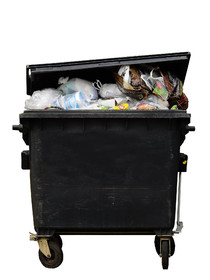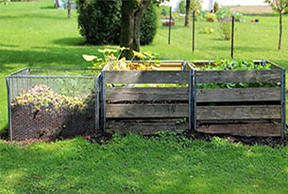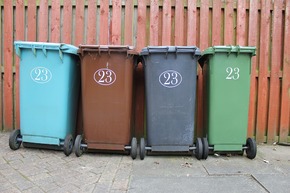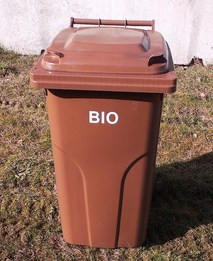Comparison of methods for disposal of organic waste
Let's take a detailed look at various ways of disposing of organic waste from the kitchen.
How can I best get rid of quickly decomposing kitchen waste containing food leftovers, sauces, and soups, meat leftovers, dumplings, etc., when I am an ordinary citizen of the Czech Republic living in a panel or family house, and want to be environmentally friendly?
Throw straight into the mixed waste bin

The rotting kitchen waste is rapidly decomposing in the trash can. Unpleasant odor and allergenic substances are entering, thus increasing the amount of unpleasant insects that threaten the health of family members.
When kitchen waste is thrown into the mixed waste bin, it becomes contaminated and is no longer suitable for further processing as a valuable energy source; it must be deposited in a landfill.
The oxygen deficiency in the trash can causes this waste to emit a further putrid smell, attracting insects and rats that are highly hazardous to human health and can cause serious illnesses.
In landfills, there are biochemical reactions occurring, during which a toxic acidic leachate of organic acids and a dangerous gas methane, causing the greenhouse effect, are formed. If the bottom of the landfill is not sufficiently secured, this acidic leachate can contaminate drinking water supplies.
To utilize composting

If I want to compost kitchen waste, I must first separate it into components that can be composted and those that cannot, as not all waste can be composted. Animal components of waste definitely do not belong in the waste I want to compost. So in the kitchen where family meals are prepared, waste for composting must be separately sorted, requiring separate containers for this purpose of waste separation. Also, the separated waste decays in these containers, and therefore it must be frequently taken out to composting places.
Kitchen waste can be composted either directly in the garden of a family house or using a composting box. Some "experts" claim that composting boxes can also be used by tenants of apartment buildings. At home, where every housewife wants to have a clean and cozy home? And what about the resulting compost when I live in a housing estate and only have a few decorative flowers in pots at home? Unfortunately, these "experts" have not yet taken this issue into consideration.
If someone has a garden and wants to compost, they must study the information about composting in professional literature, as composting must be done correctly, and only a well-made compost doesn't smell and does not contain molds, which are very dangerous for plants.
The disadvantage of composting is that the resulting compost can only be applied to the garden during the warm months of the growing season.
Use the brown trash bin for sorted waste

Brown bins are meant for composting green and food waste, such as mown grass, branches, leaves, fruit and vegetable leftovers, tea bags, coffee grounds, eggshells, bread, rice, pasta, etc. Kitchen waste containing animal waste, such as meat scraps, skin, bones, sauces with dumplings, etc., should not be put into the brown bin.
Unfortunately, in cities or towns, this waste sorting is not usually implemented in panel housing estates. So only family houses or garden settlements can use this waste sorting when they purchase the required composting container with their own money.
The system of collecting these bins from locations where individual composts cannot be established faces a technical problem - the bins are placed in spaces where there are also traditional trash cans or containers. So no matter how well you technically secure them, a rat will find its way into them because it is attracted by the smell of decaying waste, which undergoes spontaneous decomposition.
Collection of compost bins must be much more frequent than with regular mixed waste bins. The vehicles that collect the contents of compost bins consume fuel and also produce emissions that harm the environment and contribute to the greenhouse effect. Regional composting facilities are located far from residential areas, so collection vehicles have to travel long distances.
This sorting of bio-waste is also limited by the fact that the collection of compost bins is only done during the vegetation period, i.e. from the beginning of April to the end of November.
Trash bins for food waste

Garbage cans for food waste are used for collecting waste from restaurants, canteens, and kitchens.
If I want to implement this household waste sorting, I have to pay a considerable amount for this trash can and for the collection of my kitchen waste.
Quickly decaying food waste causes a strong odor, and molds, bacteria, and pathogenic germs can quickly multiply in gastro-waste containers. Therefore, collections of this waste are very common and so vehicles transporting this waste consume fuel and generate emissions causing the greenhouse effect.
To castrate livestock.
According to the law, I cannot feed farm animals with kitchen leftovers that qualify as waste and contain animal by-products. So kitchen leftovers can only be fed to household pets, i.e. companion animals.
Flush down the toilet bowl
Flushing large pieces of kitchen waste down the toilet can cause clogging of the sewage system. This then becomes food for rodents directly in the sewage system, which requires increasing costs for pest control.
Use a kitchen waste disposal.
.jpg)
The last option for effectively disposing of kitchen waste, including animal material, is using a garbage disposal unit. Using a garbage disposal unit is a convenient alternative for households because kitchen waste is sorted and disposed of directly at the source. This way, we can avoid storing rotting waste and the unpleasant odor that attracts annoying insects. The household becomes cleaner, and the kitchen area becomes more hygienic.
Without a waste disposer, sediment can gradually accumulate in the waste pipes, formed by the buildup of food remnants and fats that stick to the walls of the pipes.
By placing food residues on the walls of the pipes, you can prevent it by installing a garbage disposal and flushing it with cold water, in which the fats solidify. If we leave the garbage disposal running and the water still running for 15 seconds after crushing the food residues, the fat coagulates and fine food particles will quickly pass through the pipes without the risk of getting caught on the pipe walls.
Because food waste consists of at least 70% water, the garbage disposal reduces the overall volume of waste leaving the household, thus reducing the amount of this waste deposited in landfills, which is beneficial for the environment.
The garbage disposal grinds waste into very small particles the size of half a grain of rice, so that even a rat would not be able to gnaw on such waste consistency.
By crushing food waste in the kitchen disposer, wastewater with the consistency of "diluted juice" is created. This wastewater is easily flushed through the sewer pipes to the wastewater treatment plant, where microorganisms in biological treatment plants are then provided with food containing nutrients necessary for the proper functioning of the wastewater treatment plant.


